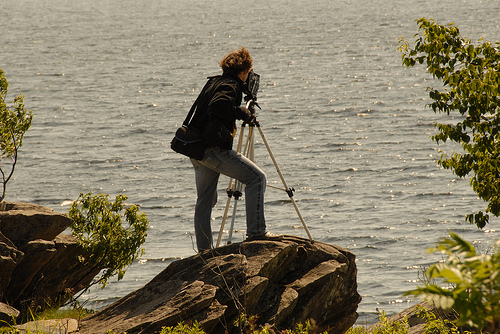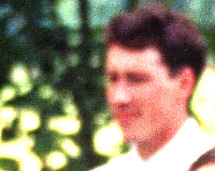Friday, February 7, 8 pm
CineCycle 129 Spadina Ave. Rear
$2 members/ $4 non-members
Jeffrey Paull is best known for his teaching prowls in Sheridan College. Who could’ve known he’s been gathering a small horde of his very own super 8 movies — three minute miniatures photographed across North America, narratives of attention which soon take the place of shiatsu massage, chiropractors, and warm baths.
Tonight’s program also stars John Kneller, Canada’s best unknown experimental filmmaker. This mini-retrospective features documentaries on the G7 Summit, Yonge Street evangelism and a gaggle of mind-bending, optical delicacies guaranteed to stop a raging rhino in its tracks at fifty paces. Chocolate cake for the eyes.
Notes:
Local Heroes
Films by Jeffrey Paull & John Kneller
Friday, February 7, 8 pm
CineCycle, 129 Spadina Ave. Rear
Jeffrey Paull
Part 1: Silents
1. Mary’s Table Cloth
2. Billowing Bedspread
3. Curtain Heather’s Room Mid-day
4. Curtains: Heather’s Room
5. Jane on the Levee
Part 2: Sound
1. Bug Death
2. Z Eats the Meaty Bone
3. Oxford Spa
4. Kris Chews Spaghetti
5. Jane in the Breeze
(All films 3.5 minutes super-8)
John Kneller
Spring 4 min, 16mm, 1991
Shimmer 4 min, 16mm, 1988
Traces, Fragments 4 min, Regular 8, 1986
Picture Start 2 min, silent, 16mm, 1985-90
Tier 6.5 min, 16 mm, 1991
Speck 4.5 min, 16mm, 1989
Toronto Summit 6.5 min, 16mm, 1988
We Are Experiencing Technical Difficulties. Regular Programming Will Resume Momentarily 16 min, silent, 16 mm, 1996
Jeffrey Paull
Part 1: Silent
1. Mary’s Table Cloth
There’s a red table cloth, two chairs, a wall of windows, and a heave of bushes billowing in the wind. Out of these spare elements Jeffrey produces a dialogue of imaginary sitters, the red curtain bearing their unspoken desires between them.
2. Billowing Bedspread
Ever worried about hanging your laundry out to dry? Wonder what secrets the neighbours might read into the dripping rows of possible personas? Here Jeffrey meditates on a mysterious hole torn into a bed sheet, as it flutters on a summer’s porch.
3. Curtain Heather’s Room Mid-day
You know those terrible mornings when you just can’t get out of bed. You sit staring out the window for hours at a time? Here a drape express a quiet longing for a world out of doors, pushing against the screen which separates inside and out. And who is Heather?
4. Curtains: Heather’s Room
Magic hour. And then a golden light the drapes withold, as if the direct vision of this scene would grow unbearable. Make its seer blind.
5. Jane on the Levee
A woman and a man with cameras. Video meets film. Two cameras meet, tentatively, pursue one another, retreat, techno-fuck.
Part 2: Sound
1. Bug Death
A minimalist’s urban documentary. Owing to the profusion of summer insects, electrified bug killers were installed in some American cities, each blue zap signalling sure death. Below cars pass heedless of the slaughter going on just a few feet away. The gentlest of protest films.
2. Z Eats The Meaty Bone
In extreme close-up, Z (pronounced Zee) chews contentedly on a bone. The introduction of a microphone asks whether we are hearing the dog or the technology, or whether his bone is just another instance of technological communion, his desire inscribed in the boneyards of all those unable to voice their desires, who must bear the marks and trespasses of the living.
3. Oxford Spa
A singing lesson – and all the views, matters and unobserved ephemera of the world which remain unseen in this celebration of the voice, this concentration lent to a single sense. As her singing provides an impromptu soundtrack for events outside the room, the camera ponders the mysterious, inexplicable relation between things in the world.
4. Kris Chews Spaghetti
A portrait rendered in real time of Kris. The title says it all.
5. Jane In The Breeze
She stands, her eyes closed, letting the wind flow through her, inventing the world via her imagination, while the camera slowly accepts her surround, re-placing her setting, her understanding, in ever widening rectangles of conscience.
John Kneller
Spring 4 min 1991
This brightly hued cine-poem is a walk through the natural world, its slowly gathered rounds of superimposition conjuring a season of renewal and re-awakening.
Shimmer 4 min 1988
This early short already shows Kneller’s characteristic image manipulations, lyric sensibilities and insistence on a simultaneous presentation. The central figure of this film poem is a distorting mirror, reflecting from a distance the stern grid of an apartment block, rendered now in wavy lines of loopy abstractions. This conversion of material into immaterial, from normative representations closes with an image of a window plant, as if these cycles of transformation had emerged from a plant’s vision after all, its conversion of sunlight into oxygen (photosynthesis) an emblem for the transformative power of seeing.
Traces, Fragments 4 min, Regular 8mm, 1986
Begun with a roll of found footage which had been improperly processed, Kneller conjures a materialist gem out of discarded pictures which are only too familiar. These are home movies showing a child playing in the bath, exploring a universe of toys, these early moments summoning the site of home as the place of reproduction. Crammed with gelatin deposits and a great, heaving, cracked surface, it struggles to transmit these memories, its material transport staggering to reproduce impressions which seem to emanate from the child instead of the filmer, giving us the unmistakable viewpoint of an untutored eye whose vision swims in the flood of the everyday.
Picture Start 2 min silent 1985-90
This lyric brief is a meditation on the natural world, its carefully wrought superimpositions of sky, leaves and chromatic close-ups a powerfully felt evocation of an animistic surround. Photographed with a keen eye for detail, Kneller’s painterly overlays collage these moments into a gently flowing homage to the present.
Tier 6.5 min 1991
Tier is a portrait of a street preacher, and the inflamed tempers he provokes as he holds forth in Toronto’s downtown core. The film closes with a montage of single framed flowers, their insistent presence throughout the film – forever potted, bound together in bouquets, or assembled in street displays – demonstrating the disingenuous impulse to contain, mediate and control nature. The preacher’s relation to his god is similar, bending his calling into a self-obsessed rant which refuses the world around him. Kneller’s gentle montage resists this singularity, pitting via montage one view in relation to another, each figure contingent on the appearance of the next.
Speck 4.5 min 1989
Speck is an ‘abstract’ drawn from nature, its close-ups of softly ebbing blues and greens cast in a serial rhythm. This pastoral sublime reawakens the hidden corners of the eye, using the most representational of mediums to document a world of colour, leaves and playground light in order to suggest an order that lies in wait beneath a vision ruled by language.
Toronto Summit 6.5 min 1988
Photographed during the convening of G7 leaders in Toronto, Kneller’s materialist documentary pits street activists against the forces of law and order. This inner city portrait shows a metropolis battened down for possible conflict – its streets closed and cordoned off while helicopters circle overhead in perpetual surveillance. As the film proceeds through dialectical montage, the two sides gather, the black shirts from windowed enclaves, and the protesters who gather to sing, dance and make speeches. Finally open conflict breaks out, as the barricades fall and both sides clash in order to lay claim again to streets too easily ceded to global oligarchy.
We Are Experiencing Technical Difficulties. Regular Programming Will Resume Momentarily 16 min 1996
For years Kneller entered autumnal treelines and photographed, often a frame at a time, allowing the flickering shards of colour to evoke an ecstatic communion of filmer and surround. Carefully re-working his original material using a complex series of mattes and superimpositions he assembled this material in two previous efforts: Architectures and Landscapes Compilation June 1994 (14 min), and Architectures and Landscapes Compilation Dec. 1994 (6 min). Two years later, these have both been re-focussed and augmented in a virtuosic display of rephotography and densely layered images.

